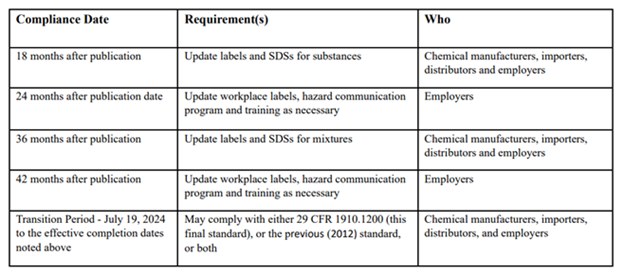The summer heat is in full swing and so are ramped-up compliance efforts from OSHA. This alert provides you with six quick tips to help avoid and minimize any “heat” from OSHA this summer.
1. Make sure your business is fully aware of the new Hazard Communication Standard. OSHA’s Hazard Communication Standard is already one of the most frequently cited standards and this trend is expected to increase in the future in light of revisions to this comprehensive standard. OSHA last published revisions to the Hazard Communication Standard (HazCom) well over a decade ago in 2012. A new standard was published on May 20, and the final rule is set to go into effect on July 19, 2024. However, OSHA has developed a tiered approach for establishments to come into compliance with the new requirements. The following table from OSHA highlights those dates:

This new standard now aligns OSHA’s requirements with the seventh revision of the Globally Harmonized System of Classification and Labeling of Chemicals adopted by the United Nations.
What could this mean for your business?
Some of the more notable HazCom standard changes include:
- New and revised criteria for the classification of certain health and physical hazards. Specifically, the new HazCom standard contains new definitions for the terms: combustible dust, gas, bulk shipment, immediate outer package, liquid, physician or other licensed healthcare professional, released for shipment, and solid.
- Updates to warning labels. Warning labels need to include “any hazards” posed by a chemical, which will warrant revised labeling for many chemicals.
- New labeling provisions for small containers. Small packing labels should be more comprehensive and readable.
- New provisions related to trade secrets.
- Technical amendments related to the contents of safety data sheets.
As reflected in the table above, chemical manufacturers, importers, and distributors may have until January 19, 2028, to comply with certain aspects of the new HazCom standard, depending on the substances and mixtures used or manufactured in their workplaces. The majority of employers using any products or substances that are covered under the new HazCom standard will need to begin updating their written HazCom program, their product labeling, and conducting certain employee training by an earlier date and may want to consult counsel about the compliance deadline specific to their business, particularly given the different deadlines for substances and mixtures.
2. Workplace Violence Prevention remains a priority. As you may have already heard, a new California law that requires almost every California employer to implement a comprehensive workplace violence prevention plan, with detailed training requirements, becomes effective on July 1, 2024. Even if your establishment is not in California, you should consider how your business can best poise itself for workplace violence prevention. Although OSHA has no comprehensive standard specifically addressing workplace violence, it can and will continue to utilize the General Duty Clause to ensure that employers are creating a safe workplace for their employees.
3. Ensure you are prepared for an OSHA inspection with the expansion of the Representatives of Employers and Employees regulation (29 CFR 1903.8). This new “Walkaround” Rule went into effect on May 31, 2024. As previously discussed in prior client alerts and a webinar, this Rule broadens the scope of who can act as an “employee representative” during an OSHA “walkaround” inspection of a facility or worksite. Importantly, an employee representative no longer must be an employee of the employer. Please note that this new Rule has been challenged by business groups led by the Chamber of Commerce of the United States of America, in the United States District Court for the Western District of Texas, Civil Action No. 24-271. To date, no stay has been issued.
4. Heat illness prevention remains a ‘hot’ topic for OSHA. A new rule expected to be entitled “Heat Illness Prevention in Outdoor and Indoor Work Settings” is expected to be published by fall. Despite the lack of a specific current standard, both indoor and outdoor heat illness have been a focus for OSHA for several years. After publishing an advance notice of proposed rulemaking in the October 27, 2021, Federal Register, OSHA issued a National Emphasis Program focusing on heat hazards and illnesses in April 2022. Then last July, OSHA issued a Heat Hazard Alert where it warned employers that it would carry out increased inspections in “high-risk industries” to make sure workers are adequately protected from heat hazards. Although those inspections were conducted under the General Duty Clause, OSHA has been actively working on a heat illness standard, publishing an outline of the elements of a proposed heat standard in August 2023. Following comment on this proposed framework, OSHA’s proposed heat illness prevention rule reached the White House Office of Management and Budget (OMB) for review on June 11. OMB reviews typically take 60 to 90 days, at which time the proposed rule will be published in the Federal Register, and employers, along with any other interested parties, will have an opportunity to comment. Be watching for a proposed heat standard to be published later this fall. In the meantime, employers should proactively evaluate what practices and policies they have in place to address heat concerns in both indoor and outdoor environments to which their workers are exposed, especially now that summer temperatures are in full swing.
5. The OSHA Whistleblower Protection Program continues to be an increasing avenue of redress for employees. This is not a new program, but it is one that we continue to see utilized by employees with increasing regularity. OSHA’s Whistleblower Program enforces protections for employees for more than 20 federal laws. You should regularly audit your policies to make sure you have taken adequate steps to avoid retaliation in the workplace.
6. Temporary workers require additional OSHA considerations. If you are hiring temporary workers this summer through a staffing agency, you should know that OSHA considers you to be a joint employer of that worker for purposes of OSHA’s training, hazard communication, and recordkeeping requirements. This means both the host employer and staffing agency can be cited for a hazardous condition affecting a temporary worker. See OSHA’s Multi-Employer Citation Policy, CPL 2-0.124. OSHA recommends that staffing agencies and host employers set out their respective OSHA compliance responsibilities in their contracts. For example, the agency and employer might agree that the agency provides general safety and health training to its temporary workers, while the employer provides site-specific hazards and equipment training and PPE. However, OSHA requires that employers maintain 300 Logs for both company and temporary workers, which may be listed separately but must be kept as a single record.
Elizabeth Haskins, a shareholder in the Charleston, South Carolina office of Baker Donelson, focuses her practice on environmental and energy litigation, regulation, and compliance. She can be reached at ehaskins@bakerdonelson.com.
Christie M. Hayes, a shareholder in the Johnson City, Tennessee office of Baker Donelson, has extensive experience in the area of workers’ compensation issues, as well as experience counseling clients on a multitude of federal and state employment laws, including the ADA and FMLA. She can be reached at chayes@bakerdonelson.com.
Ashley Meredith Strittmatter, a shareholder in Baker Donelson’s Knoxville, Tennessee office, advises and represents clients before state and federal administrative agencies and boards in both compliance efforts and enforcement defense related to various environmental, safety and health laws. She can be reached at astrittmatter@bakerdonelson.com.

